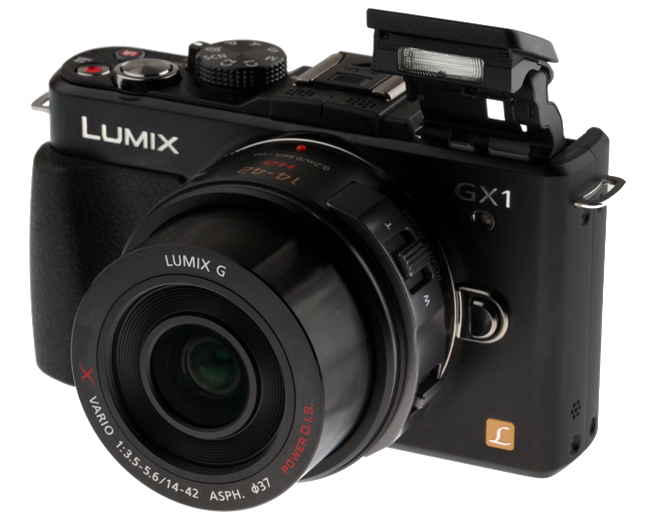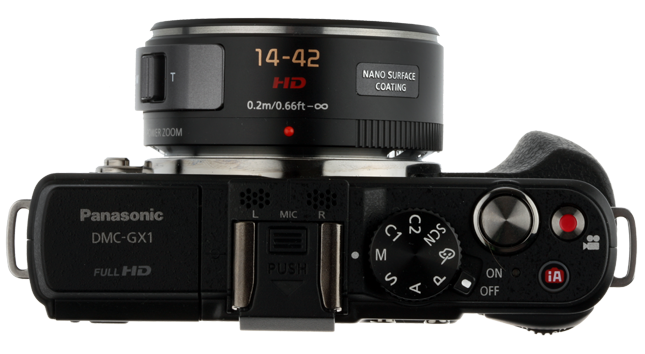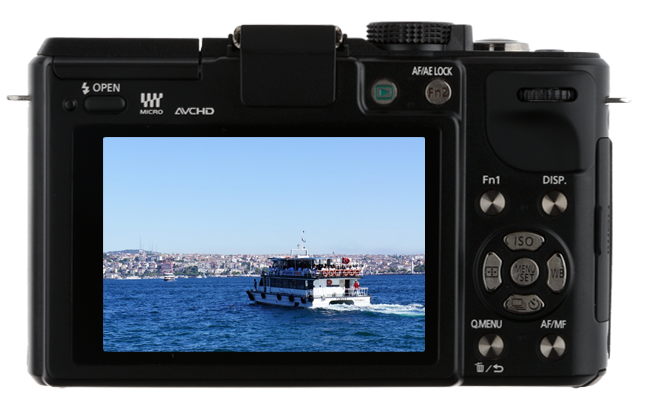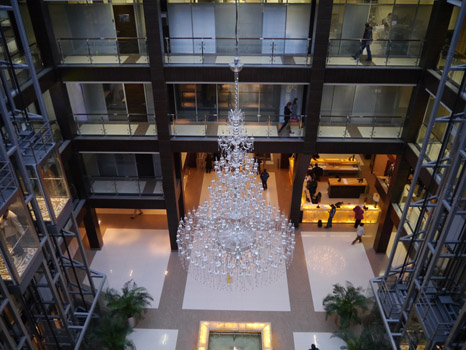Panasonic GX1 - nothing is forgotten!

After a tidy, practically GF3 ladies' model, Panasonic suddenly started up and presented the amateur photographers with a very specific, brutal machine.
Pedigree
The November new GX1 takes us back to the times of the triumph of the Panasonic mirrorless with interchangeable lenses - the GF1. And if you take a closer look, especially at the silhouette under the rangefinder and the comfortable vulcanite texture of the rubber grip, the legendary model Panasonic L1K comes to mind. By the way, I still could not find an adequate replacement for her among the crop cameras.
')
Numbers
The manufacturer claims that the Micro 4/3 matrix now has a density of 16 megapixels, and the top ISO has almost reached the sensitivity of the night vision device - ISO12800. Dashing statement, let's see what will be in the pictures. It is clear that with the same sensor area of some kind of jerk in quality and not foreseen, but as practice has shown, the dynamic range of the GF2 and GF3 models can differ. A 16 megapixels indirectly indicate the similarity of the matrix with the one that stands in the model of the upper echelon G3. But Panasonic we love not for the pixels.

Matrix Lumix GF3, Lumix GX1 and Sony NEX-5N
Execution
Superb, with the classic organization of control of shooting. Mechanical assemblies GX1 work clearly, like a good door lock. Throughout the metal, plastic can be seen except on the lenses, the battery compartment and the protective cap on the hot shoe socket. Right behind it, two perforations of the left and right channels of sound recording. There is also a built-in flash, and it can also be sent to the ceiling - well, why almost no one envisages this in their cameras? There is no optical viewfinder, but you can attach an electronic LVF2.

Lenses
The test with the GX1 received two lenses - one miniature zoom 14-42 mm F3.5-5.6, with a size of fixed 20 / 1.7, and the second - a telephoto 45-175 mm F4.0-5.6. Both come with stabilizers. As it is known, Panasonic, unlike Olympus, doesn’t fundamentally put a stabilization system inside the camera.

Control
In general - very comfortable, in the spirit of Panasonic. Plus, do not forget about rubber grip and optimal size. The classic control (keys) functionality is organically combined and even mutually duplicated with a scroller and touchscreen. The only thing with which I was too clever was the zoom control 14-42, on which there are two swing keys. One of them is responsible for the zoom itself, while the other controls the focus in the manual mode. Honestly, to manage with their help was not very convenient. Of course, you can do this through the touchscreen, but still this moment seemed unrealized humanly. There is more space on the TV, so you can zoom it manually. But the most wonderful thing to help the photographer is the level of the horizon (in two axes!) On the display, like a gyro in pilots. Very useful and handy thing.

A photo
Since the weather was far from sunny, and even with snow,
I had to take a few pictures in the room. Well, at the same time check
matrix behavior at high ISO. The minimum shooting value was at
ISO400 - let's start with it.
 |
1. At a wide angle was not without easy barrel distortion.
 |  |
2, 3. It seems the dynamic range is fine, even at ISO800. The light falls quite evenly, without failures and "blindness"
 |
4. Of course, there is no soap, but for Panasonic the clarity could have been higher. True, it can be said that it is an ISO800, pre-sales sample, and so on. But in my opinion, physics cannot be fooled, and yet this zoom is not a champion in sharpness in the Panasonic lineup.
 |  |
5, 6. Continue impudent and put ISO1600. As you can see, the flight is normal, there is no dirt, the pictures are quite adequate, if you do not look at them at 100%
 |
7. But if you shoot at the long end of 175 mm (ie, 350 mm in film equivalent) with an exposure of 1/80, it will already be lubricated, and no stabilizer will help out
 |  |
8, 9. What about ISO1600? - You are welcome! I then spun a look at ISO12800. What can I say? It turned out such a light purple toning, as they sometimes like to do in fashion photos
 |
10. I reduced the speed to ISO3200, but for such a matrix it is not too easy to work on this mode
 |
11. But ISO1250 looks absolutely safe and optimal for indoor shooting.
Video
The camera shoots Full HD in AVCHD format at 30 frames per second in 1080p or 60 frames in 1080i. Removes well, but zooming due to the keys described above on new lenses can introduce unwanted jerks into hand-held shooting.
Summary
Pros: performance, appearance, good dynamic range and the ability to high ISO in the matrix. Cons: irregular (taking into account the brand's reputation) clarity, inconvenient zoom keys on the lenses. Balanced conclusion: a perfectly executed camera that incorporates the best features of its predecessors. We are waiting for the firmware update.
Specifications
Matrix: CMOS, 17.3 x 13 mm
Total megapixels: 16.6 megapixels
Effective megapixels: 16 megapixel
The possibility of changing the lens: yes
Lens type: Panasonic 14-42 whale
Manual white balance: yes
ISO range: 160 - 12800 ISO
Exposure range: 60 - 1/4000 s
Viewfinder type: electronic
Display: TFT, touch, diagonal 3 ", resolution 460 000 points
Live view: yes
Flash: built-in hot shoe
Image Stabilization: Optical
Burst speed: 4.2 frames / second
Record Format: .raw, .jpeg
Maximum image resolution: 4592 x 3448
Video shooting: yes
The maximum video resolution: 1920x1080 / 30p (1920x1080 / 60i)
Internal memory: no
Memory Cards: SD
Connectors: USB, video, HDMI, audio, connector for remote control
Dimensions: 116 x 68 x 39 mm (without lens)
Weight: 318 g (with battery, without lens)
Price: in the "whale" from 14-42 - $ 800 in the US;
PS Sorry for the slightly curved tablet - Habr does not allow it to be specially edited :)
Source: https://habr.com/ru/post/133743/
All Articles